![]() There is widespread agreement that high school is too late to begin to expose learners to careers and the foundational skills needed to access and succeed in careers, but there remains a lack of consensus about what CTE and career readiness should entail at the middle grades level.
There is widespread agreement that high school is too late to begin to expose learners to careers and the foundational skills needed to access and succeed in careers, but there remains a lack of consensus about what CTE and career readiness should entail at the middle grades level.
Advance CTE, with support from ACTE, convened a Shared Solutions Workgroup of national, state and local leaders to identify the core components of a meaningful middle grades CTE experience. This collaboration resulted in Broadening the Path: Design Principles for Middle Grades CTE and a companion blog series exploring each of the core programmatic elements of middle grades CTE defined in the paper. In this fifth entry in the blog series, we will examine the core programmatic element of experiential learning, which includes career and technical student organizations (CTSOs).
CTSOs benefit middle grades students by engaging them in learning about themselves, their community and potential careers. These co-curricular organizations provide learners with opportunities to learn about and demonstrate technical and leadership skills, participate in hands-on activities through competitive events and support their schools and communities through service activities.
State and districts around the country are harnessing CTSOs to help middle school students explore careers and their occupational identities. North Carolina, which already offers widespread CTSO opportunities in the middle grades, is revising its approach to middle grades CTE. CTSOs will be one of four key components in a new middle grades CTE framework, which will be supported by 15-hour modules for CTE instructors that address career exploration, essential employability skills, basic concepts and nomenclature, and the integration of CTSO activities within programs. In addition, the state has hired a staff person to focus on middle grades CTE. North Carolina further prioritizes CTSOs in a number of ways, including a section of the Perkins V comprehensive local needs assessment dedicated to evaluating CTSO access and quality at both middle and high school levels.
South Carolina is growing its CTSO participation in middle school. SC HOSA has a middle grades division and an annual middle school conference, including competitive events in medical terminology, health education and health career display. So far, only a handful of middle schools are competing, but these middle schools chapters are engaged and active. For instance, the York Middle School HOSA chapter began in 2016. In addition to competitive events, this chapter has volunteered at a long-term care center, participated in a mock HOSA Bowl with high school peers and connected with HOSA alumni.
Colorado FCCLA opened up opportunities to middle school students in 2011, and Kelly Gauck of Holmes Middle School jumped at the chance to incorporate FCCLA into the family and consumer sciences program. After what she describes as a huge learning curve, all three competitors from the school who attended national competitions in 2013 won gold medals. The chapter has also been very active in its community, making blankets for a local children’s hospital, holding food drives and donating games, toys, food, toiletries and more to those in need. Gauck has been recognized for her work with the national FCCLA Spirit of Advising Award.
As you reflect on this element of middle grades CTE in your state, district or school, consider such questions as:
- Are CTSOs available to all middle grades students?
- Are there efforts to identify and eliminate barriers to access, participation and success in CTSOs for marginalized or special populations of students?
- Are there clear standards for CTSOs, either from a national organization and/or from state criteria for recognition?
- Are educators provided with the time, resources and supports necessary to implement quality CTSO experiences?
- How are middle grades CTSO experiences connected to high school CTSO opportunities?
- How are employers involved in CTSOs through competitive events, mentoring or other activities?
- How are students and their families provided adequate information on CTSO opportunities?
- How are CTSO opportunities evaluated or monitored to ensure student growth?
For additional resources relevant to middle grades CTSOs, check out the Middle Grades CTE Repository, another deliverable of this Shared Solutions Workgroup.


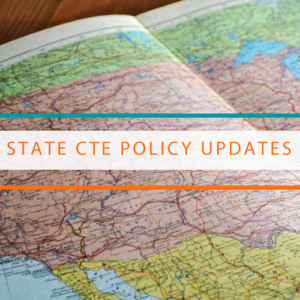 Many governors leveraged their State of the State Addresses to address CTE funding. In Maine,
Many governors leveraged their State of the State Addresses to address CTE funding. In Maine, 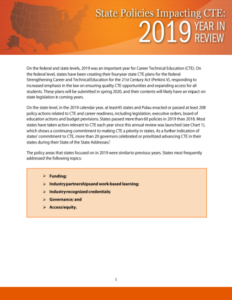 On the federal and state levels, 2019 was an important year for Career Technical Education (CTE). In addition to creating their four-year state plans for the federal Strengthening Career and Technical Education for the 21st Century Act (Perkins V), at least 45 states and Palau enacted at least 208 policy actions related to CTE and career readiness.
On the federal and state levels, 2019 was an important year for Career Technical Education (CTE). In addition to creating their four-year state plans for the federal Strengthening Career and Technical Education for the 21st Century Act (Perkins V), at least 45 states and Palau enacted at least 208 policy actions related to CTE and career readiness. Some states are exploring how to leverage apprenticeships to award college credit to learners. For instance, the Colorado legislature passed
Some states are exploring how to leverage apprenticeships to award college credit to learners. For instance, the Colorado legislature passed 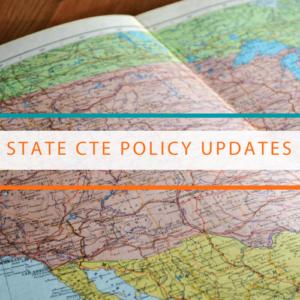 In Virginia and New Mexico, the state legislatures have taken action to expand opportunities for CTE learners. In Virginia, on March 5,
In Virginia and New Mexico, the state legislatures have taken action to expand opportunities for CTE learners. In Virginia, on March 5,  Earlier this summer, Advance CTE in partnership with Education Strategy Group (ESG) and the Council of Chief State School Officers (CCSSO), released
Earlier this summer, Advance CTE in partnership with Education Strategy Group (ESG) and the Council of Chief State School Officers (CCSSO), released 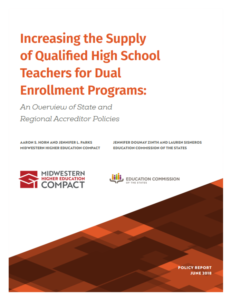 The report found that criteria for qualifying Career Technical Education (CTE) instructors are mentioned in state-level policies in eight states (Colorado, Illinois, Kansas, Maine, Missouri, Mississippi, Ohio, Virginia). Dual enrollment teacher qualification policies are generally related to education attainment level, but exemptions are sometimes made for CTE dual enrollment instructors. In some of these cases, states allow exemption from qualification rules when instructors can demonstrate proficiency in the field they will teach and consider industry recognized credentials and years of experience working in the field when determining teacher qualifications.
The report found that criteria for qualifying Career Technical Education (CTE) instructors are mentioned in state-level policies in eight states (Colorado, Illinois, Kansas, Maine, Missouri, Mississippi, Ohio, Virginia). Dual enrollment teacher qualification policies are generally related to education attainment level, but exemptions are sometimes made for CTE dual enrollment instructors. In some of these cases, states allow exemption from qualification rules when instructors can demonstrate proficiency in the field they will teach and consider industry recognized credentials and years of experience working in the field when determining teacher qualifications.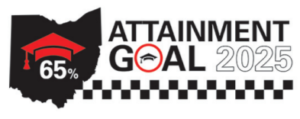 Similarly, in Ohio, three community colleges
Similarly, in Ohio, three community colleges The demand for Bachelor’s degrees may be
The demand for Bachelor’s degrees may be  In Vermont, Governor Phil Scott announced the launch of a new initiative called
In Vermont, Governor Phil Scott announced the launch of a new initiative called